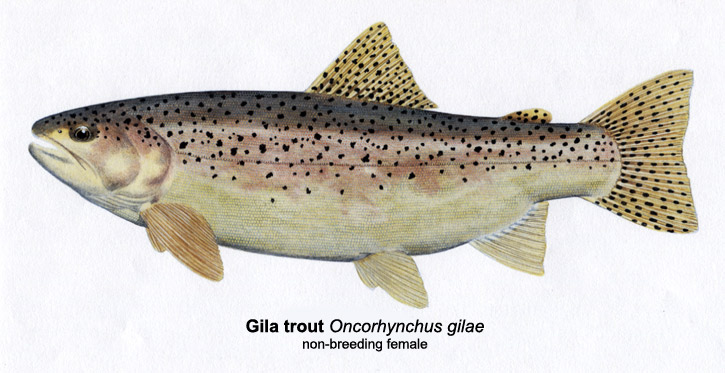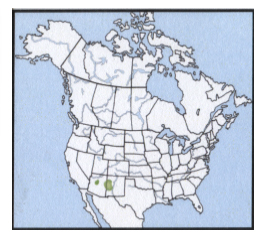Gila Trout, May 2011, Fish of the Month!
 Gila Trout
Gila Trout
Oncorhynchus gilae
Local Names:
Gila Trout
Average Size:
8 to 12 inches
Distinguishing Field Marks:
Color and color pattern are reliable distinguishing field marks for this species. (See the illustration.)
-
The fins, especially the dorsal and tail fins are distinctly larger than those of a typical trout.
-
The overall color is unusual; pale yellow on the belly under pale reddish sides and a brown back.
-
There are many irregular black spots on the back, dorsal, adipose, and tail fins. There are only a few spots below the lateral line.

North American Range:
Map to the right shows approximate range in North America.
Diet:
Throughout their lives, these typically small trout feed on a broad range of aquatic and terrestrial insects as they become available.
Fly Fishing for Gila Trout:
This is another of our “heritage” species of native North American true trout. Like the Mexican Golden trout, the Gila trout’s range is very limited. Carefully study all state and local regulations before you fish for Gila trout. These vary widely. In some of its re-established waters, no fishing is permitted. In others there is a two fish limit, but this is in areas where Gila trout have hybridized with Rainbow trout and are no longer pure-bred. Keep in mind that this lovely fish was listed on the Federal Endangered Species List as recently as 1966. Intensive habitat and species restoration efforts coupled with education and strictly enforced fishing and bag regulations has resulted in the return of “fishable” numbers of this trout in parts of its historic native range. Nevertheless, Gila trout are still considered a threatened species.
After you’ve made a commitment to find Gila trout within their typically high altitude range and have got yourself away from “the beaten path,” present your insect imitations on light tackle. Nothing heavier than 3 or 4 weight systems are suggested. Match-the-hatch will be the order of the day when in Gila trout waters. Find the water, find the fish, then sit or stand a while just observing what’s going on there. Respect for this trout’s habitat and respect for this trout and its place in the web of life will be the basis of a satisfying outing. We also recommend, because this trout’s station in the world is still very tenuous, that you either use flies with barbless hooks or that you crush the barbs on barbed hooks. (If you’ve never done this, just squeeze the barb down with a pair of needle-nose pliers.) In fact, barbed hooks, because of the barb, are slower to penetrate, much more likely to injure a fish, and MUCH harder to remove when the fish is at hand and about to be released; so, this author highly recommends barbless hooks for all your fly fishing. Oh yeah, especially with threatened species such as this one, if you want future angling opportunities, “put ‘em back alive; ” barbless hooks make that much easier and safer to do.
p.s. For you all who’re wondering when we’re going to get to some big fish? Next month, we dig into the Pacific salmon!!!! A bit late maybe for some of the early runs, but, timely nonetheless……Me? I’ve never met a fish I didn’t like.






